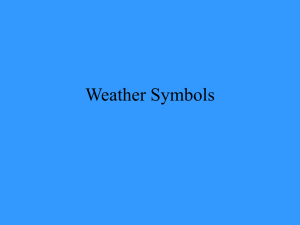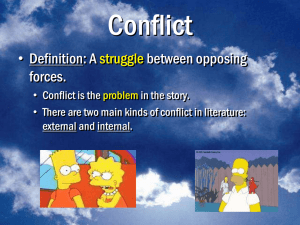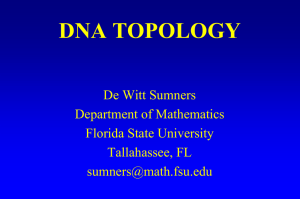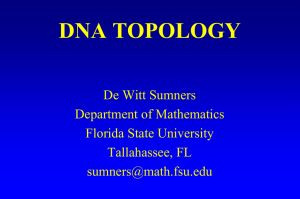Topological Methods in Physcial Virology
advertisement
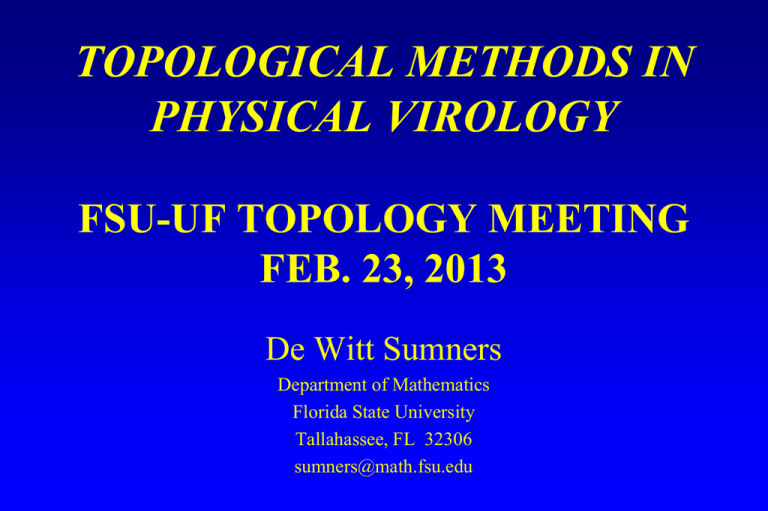
TOPOLOGICAL METHODS IN PHYSICAL VIROLOGY FSU-UF TOPOLOGY MEETING FEB. 23, 2013 De Witt Sumners Department of Mathematics Florida State University Tallahassee, FL 32306 sumners@math.fsu.edu DNA Replication TOPOLOGICAL VIROLOGY • Using DNA plasmids as an assay for site-specific recombination—deduce viral enzyme binding and mechanism • Using DNA knots to elucidate packing geometry and ejection of DNA in viral capsids A Little Entanglement Can Go a Long Way DNA KNOTTING IS LETHAL IN BACTERIA • Promotes replicon loss by blocking DNA replication • Blocks gene transcription • Causes mutation at a rate 3 to 4 orders of magnitude higher than an unknotted plasmid Diebler et al, BMC Molecular Biology (2007) 8:44 Crossover Number CHIRALITY Knots and Catenanes Prime and Composite Knots A Knot Zoo By Robert G. Scharein http://www.pims.math.ca/knotplot/zoo/ © 2005 Jennifer K. Mann T ORUS KNOTS TWIST KNOTS Topological Enzymology Mathematics: Deduce enzyme binding and mechanism from observed products Strand Passage Topoisomerase Strand Exchange Recombinase GEL ELECTROPHORESIS RecA Coated DNA DNA Trefoil Knot Dean et al., J BIOL. CHEM. 260(1985), 4975 l DNA (2,13) TORUS KNOT Spengler et al. CELL 42 (1985), 325 T4 TOPOISOMERASE TWIST KNOTS Wassserman & Cozzarelli, J. Biol. Chem. 266 (1991), 20567 PHAGE m GIN KNOTS Kanaar et al. CELL 62(1990), 553 Topoisomerase Knots D Topoisomerase Knots Dean et al., J BIOL. CHEM. 260(1985), 4975 GEL VELOCITY IDENTIFIES KNOT COMPLEXITY Vologodskii et al, JMB 278 (1988), 1 SITE-SPECIFIC RECOMBINATION Biology of Site-Specific Recombination • Integration and excision of viral genome into and out of host genome • DNA inversion--regulate gene expression & mediate phage host specificity • Segregation of DNA progeny at cell division • Plasmid copy number regulation RESOLVASE SYNAPTIC COMPLEX DNA 2-STRING TANGLES 2-STRING TANGLES 3 KINDS OF TANGLES A tangle is a configuration of a pair of strands in a 3-ball. We consider all tangles to have the SAME boundary. There are 3 kinds of tangles: RATIONAL TANGLES TANGLE OPERATIONS RATIONAL TANGLES AND 4-PLATS 4-PLATS (2-BRIDGE KNOTS AND LINKS) 4-PLATS TANGLE EQUATIONS RECOMBINATION TANGLES SUBSTRATE EQUATION PRODUCT EQUATION TANGLE MODEL SCHEMATIC Ernst & Sumners, Math. Proc. Camb. Phil. Soc. 108 (1990), 489 Tn3 RESOLVASE PRODUCTS RESOLVASE MAJOR PRODUCT • MAJOR PRODUCT is Hopf link [2], which does not react with Tn3 • Therefore, ANY iterated recombination must begin with 2 rounds of processive recombination RESOLVASE MINOR PRODUCTS • Figure 8 knot [1,1,2] (2 rounds of processive recombination) • Whitehead link [1,1,1,1,1] (either 1 or 3 rounds of recombination) • Composite link ( [2] # [1,1,2]--not the result of processive recombination, because assumption of tangle addition for iterated recombination implies prime products (Montesinos knots and links) for processive recombination 1st and 2nd ROUND PRODUC TS RESOLVASE SYNAPTIC COMPLEX Of = 0 THEOREM 1 PROOF OF THEOREM 1 • Analyze 2-fold branched cyclic cover T* of tangle T--T is rational iff T* = S1 x D2 • Use Cyclic Surgery Theorem to show T* is a Seifert Fiber Space • Use results of Dehn surgery on SFS to show T* is a solid torus--hence T is a rational tangle • Use rational tangle calculus to solve tangle equations posed by resolvase experiments 3rd ROUND PRODUCT THEOREM 2 4th ROUND PRODUCT UTILITY OF TANGLE MODEL • Precise mathematical language for recombinationallows hypothesis testing • Calculates ALL alternative mechanisms for processive recombination • Model can be used with incomplete experimental evidence (NO EM)--crossing # of products, questionable relationship between product and round of recombination • Proof shows there is NO OTHER explanation of the data REFERENCES JMB COVER Crisona et al, J. Mol. Biol. 289 (1999), 747 BACTERIOPHAGE STRUCTURE T4 EM HOW IS THE DNA PACKED? SPOOLING MODEL RANDOM PACKING P4 DNA has cohesive ends that form closed circular molecules GGCGAGGCGGGAAAGCAC …... CCGCTCCGCCCTTTCGTG GGCGAGGCGGGAAAGCAC CCGCTCCGCCCTTTCGTG …. Liu et al P2 Knots (33kb) VIRAL KNOTS REVEAL PACKING • Compare observed DNA knot spectrum to simulation of knots in confined volumes EFFECTS OF CONFINEMENT ON DNA KNOTTING • No confinement--3% knots, mostly trefoils • Viral knots--95% knots, very high complexity-average crossover number 27! MATURE vs TAILLESS PHAGE Mutants--48% of knots formed inside capsid Arsuaga et al, PNAS 99 (2002), 5373 P4 KNOT SPECTRUM 97% of DNA knots had crossing number > 10! Arsuaga et al, PNAS 99 (2002), 5373 2D GEL RESOLVES SMALL KNOTS Arsuaga et al, PNAS 102 (2005), 9165 PIVOT ALGORITHM • Ergodic—can include volume exclusion and bending rigidity • Knot detector—knot polynomials (Alexander, Jones, KNOTSCAPE) VOLUME EFFECTS ON KNOT SIMULATION • On average, 75% of crossings are extraneous Arsuaga et al, PNAS 99 (2002), 5373 SIMULATION vs EXPERIMENT n=90, R=4 Arsuaga et al, PNAS 102 (2005), 9165 EFFECT OF WRITHE-BIASED SAMPLING n=90, R=4 Arsuaga et al, PNAS 102 (2005), 9165 CONCLUSIONS • Viral DNA not randomly embedded (41and 52 deficit, 51 and 71 excess in observed knot spectrum) • Viral DNA has a chiral packing mechanism--writhebiased simulation close to observed spectrum • Torus knot excess favors toroidal or spool-like packing conformation of capsid DNA • Next step--EM (AFM) of 3- and 5- crossing knots to see if they all have same chirality NEW PACKING DATA—4.7 KB COSMID • Trigeuros & Roca, BMC Biotechnology 7 (2007) 94 CRYO EM VIRUS STRUCTURE J i a n g e t a l N A T U R E 4 DNA-DNA INTERACTIONS GENERATE KNOTTING AND SURFACE ORDER • Contacting DNA strands (apolar cholosteric interaction) assume preferred twist angle Marenduzzo et al PNAS 106 (2009) 22269 SIMULATED PACKING GEOMETRY Marenduzzo et al PNAS 106 (2009) 22269 THE BEAD MODEL • Semiflexible chain of 640 beads--hard core diameter 2.5 nm • Spherical capsid 45 nm • Kink-jump stochastic dynamic scheme for simulating packing KNOTS DELOCALIZED Black—unknot; 91—red; complex knot--green Marenduzzo et al PNAS 106 (2009) 22269 SIMULATED KNOT SPECTRUM Marenduzzo et al PNAS 106 (2009) 22269 DNA-DNA INTERACTION CONCLUSIONS • Reproduce cryo-em observed surface order • Reproduce observed knot spectrum—excess of torus knots over twist knots • Handedness of torus knots—no excess of right over left at small twist angles—some excess at larger twist angles and polar interaction REFERENCES • Nucleic Acids Research 29(2001), 67-71. • Proc. National Academy of Sciences USA 99(2002), 5373-5377. • Biophysical Chemistry 101-102 (2002), 475-484. • Proc. National Academy of Sciences USA 102(2005), 9165-9169. • J. Chem. Phys 124 (2006), 064903 • Biophys. J. 95 (2008), 3591-3599 • Proc. National Academy of Sciences USA 106(2009), 2269-2274. JAVIER ARSUAGA, MARIEL VAZQUEZ, CEDRIC, EITHNE CHRISTIAN MICHELETTI, ENZO ORLANDINI, DAVIDE MARENDUZZO ANDRZEJ STASIAK COLLABORATORS Mathematics: Claus Ernst, Mariel Vazquez, Javier Arsuaga, Steve Harvey, Yuanan Diao, Christian Laing, Nick Pippenger, Stu Whittington, Chris Soteros, Enzo Orlandini, Christian Micheletti, Davide Marenduzzo Biology: Nick Cozzarelli, Nancy Crisona, Sean Colloms, Joaquim Roca, Sonja Trigeuros, Lynn Zechiedrich, Jennifer Mann, Andrzej Stasiak Thank You •National Science Foundation •Burroughs Wellcome Fund UNKNOWN P4 KNOT UNKNOWN P4 KNOTS AFM Images of Simple DNA Knots (Mg2+) μm Ercolini, Dietler EPFL Lausanne μm μm


